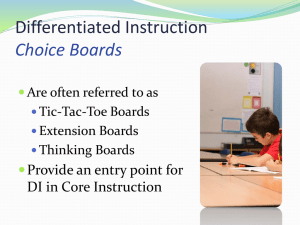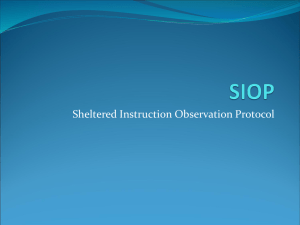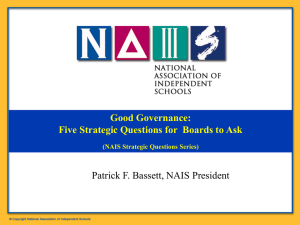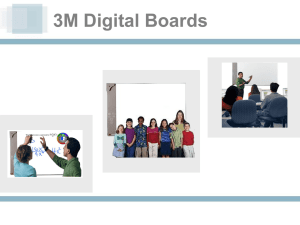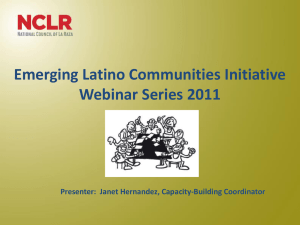For New Trustees & Governance 201 PPT
advertisement
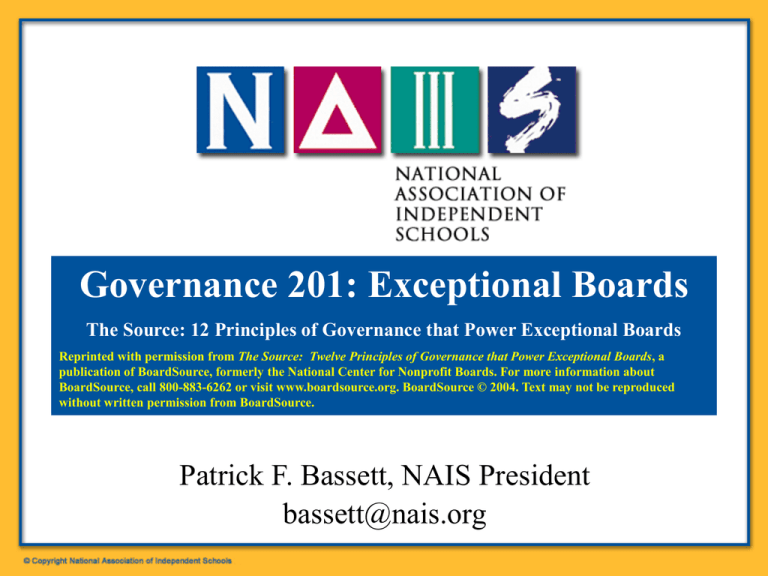
Governance 201: Exceptional Boards The Source: 12 Principles of Governance that Power Exceptional Boards Reprinted with permission from The Source: Twelve Principles of Governance that Power Exceptional Boards, a publication of BoardSource, formerly the National Center for Nonprofit Boards. For more information about BoardSource, call 800-883-6262 or visit www.boardsource.org. BoardSource © 2004. Text may not be reproduced without written permission from BoardSource. Patrick F. Bassett, NAIS President bassett@nais.org Up to your Elbows in Routine Crises? See PFB on Twitter: Tweeters & Followers PatBassett We know it’s impossible to make everyone happy. It may be impossible to make anyone happy. Key to successful leadership: Hire happy people. .5:09 PM Jul 6th from web PatBassett Made a terrible blunder you need time to fix? Buy time by proposing a change in the dress code: everyone will be distracted for months. less than 5 seconds ago from web PatBassett Casey Stengel Leadership Lesson: “The key to being a good manager is keeping the people who hate me away from those who are still undecided.” 8:36 PM Jun 22nd from web Board Conundrums SIX PHASES OF A PROJECT by the Board 1. ENTHUSIASM 2. DISILLUSIONMENT 3. PANIC 4. SEARCH FOR THE GUILTY 5. PUNISHMENT OF THE INNOCENT 6. PRAISE AND HONORS FOR THE NON PARTICIPANTS. "A school is a relatively small institution with a complexity out of all proportion to its size." Damon Bradley, former school head What Are the Three Top Governance Challenges in Schools (Source: Nine contributors to the Trustee Handbook, International Edition) 1. ROLE CONFUSION LEADS TO “MICRO-MANAGEMENT” (a definitional problem) 2. HIGH TRUSTEE TURNOVER IMPEDES BOTH BOARDS AND HEADS (a structural process problem) 3. POOR UNDERSTANDING AND POOR SKILLS REDUCE EFFECTIVENESS (an education problem) What Business Execs Don’t Know -But Should-About Nonprofits By Les Silverman & Lynn Taliento, Stanford Social Innovation Review, Summer 2006 CEOs and other business leaders on non-profit boards too often… can’t identify with the 5 top challenges: 1. The non-profit leader wields less authority and control than his or her for-profit counterparts (Jim Collins’ legislative vs. executive leadership). 2. Yet the non-profit leader must answer to a wider range of stakeholders. 3. The enterprise lacks straightforward performance measures – there are no analogs to profit in social change. 4. Yet the non-profit is under greater scrutiny from politicians and the press (and in the case of schools, the customers). 5. Compared to the corporate world, the nonprofit sector is under- funded, under-staffed, under-resourced, and under-trained. What’s the Antidote to the Malaise? Board Development and Self-Improvement 1. Exceptional Boards ~ The Source: 12 Principles of Governance that Power Exceptional Boards (BoardSource.org) 2. The NAIS Trustee Handbook (www.nais.org): 9th Edition (US) or International Edition (abroad) 1. Constructive Partnership Exceptional boards govern in constructive partnership with the head, recognizing that the effectiveness of the board and head are interdependent Responsible Boards x Source of Power = Exceptional Boards Delegate operations to the head Trust, candor, and respect Face and resolve problems easily Evaluate head annually Sharing good and bad news Attract more qualified head Ensure fair, competitive compensation Communication in and between meetings Retain talented head longer Develop a job description with and for the head PFB: Constantly clarify boundaries. Open and honest head Change executive leadership at the right time Insightful tools and information PFB: Have a succession plan in place for school head Typical Dilemma: Once a issue or crisis identified, the board wants quick decisions. Fails to co-define and prioritize the head’s role. 2. Mission Driven Exceptional boards shape and uphold the mission, articulate a compelling vision, and ensure the congruence between decisions and core values. Responsible Boards Articulate clear statement of mission Uphold organizational values PFB: Know that great schools are “built to last.” (J&J; Disney; GE) PFB: Create “pithy,” “sticky” mission statement/value promise. x Source of Power Use of mission, vision, and values in decision making Congruence between mission, vision, values, and day-to-day work Willingness to refocus mission = Exceptional Boards Sharply address community needs Inspire staff to reframe strategies and elevate goals Improve advocacy, fundraising, and marketing Maximize the value of grants and contributions PFB: mission map; Typical Dilemma: Tendency to waffle on values and agreed-upon rolesalignment when the mission/resource heat is on, especially as the school attorney counsels withholding info or parents begin making “the complaint call.” (Cf. NAIS’s Debra Wilson & Jane Hulbert) 3. Strategic Thinking Exceptional boards allocate time to what matters most and continuously engage in strategic thinking to hone the organization’s direction. Responsible Boards Set direction Establish and review strategic plans Monitor performance against plans PFB: “Strategic planning is an oxymoron.” ~Henry Mintzberg x Source of Power Considerable time spent on consequential issues Constant strategic thinking Joint board-staff efforts to frame and explore issues Alignment of agendas and head’s goals with priorities = Exceptional Boards Become a strategic asset and a source of leadership Sharpen direction, address difficult issues, identify opportunities Generate solutions that are understood and supported Typical Dilemma: Derailed from the strategic conversation to the mundane. 4. Culture of Inquiry Exceptional boards institutionalize a culture of inquiry, mutual respect, and constructive debate that leads to sound and shared decision-making Responsible Boards x Source of Power = Exceptional Boards Have members who work well with each other Receive and review materials in advance Mutual respect and trust Engage and energize their members Actively-managed group dynamics Expose full range of opinions Convene well-organized meetings Openness to questions, challenges, and differences of opinion Multiple sources of information Make better decisions Focus meetings on Own and support their fiduciary duties (but decisions (PFB: the “loyal only part of the time) opposition”) PFB: Build board as a Typical Dilemma: Board a “huddle of quarterbacks” instead of a team. team. Recruit to balance Notteam. all the voices heard so individuals trump “the crowd.” Meet too often. the 5. Independent Mindedness Exceptional boards are independent-minded. When making decisions board members put the interests of the organization above all else. Responsible Boards x Source of Power = Exceptional Boards Adopt conflict-ofinterest policies Unqualified loyalty Make decisions in the best interest of organization Disclose and do not vote on matters of personal interest Independent thinking drawn from multiple sources Decision making free of undue influence Minimize risk of poor decisions and negative publicity PFB: Balance current parents with nonparents. Faculty on committees, not board. Rigorous conflict-ofinterest procedures Typical Dilemma: Board members ignore or neglect policy and identify with self-interest of their own tribe 6. Ethos of Transparency Exceptional boards promote an ethos of transparency by ensuring that donors, stakeholders, and the interested members of the public have access to information regarding finances, operations, and results. Responsible Boards Comply with government filing requirements Report annually on accomplishments and use of funds PFB: Make board business transparent, on the website as counter to “attack” websites. x Source of Power = Exceptional Boards Active exchange between board and staff Alongside staff, feel connected to the organization Openness with donors and the public Cultivate relationships with donors and stakeholders Whistle-blower policies to protect staff (but NOT a board Grievance Committee) Earn public trust and support Typical Dilemma: Lack of “sunshine” on board operations, goals, and priorities; or the opposite, wandering into staff evaluations. (Walk in the woods case study.) 7. Compliance with Integrity Exceptional boards promote strong ethical values and disciplined compliance by establishing appropriate mechanisms for oversight. Responsible Boards Ensure compliance with the law. Revise bylaws. Due diligence on risk. Approve budget and review financial reports x Source of Power Financially attentive and astute board members Vigorous oversight = Exceptional Boards Judiciously allocate and oversee resources Deeply understand their organizations Obtain independent Proactive risk Minimize risk review or audit of management financialDilemma: statements Unaccustomed to scrutinizing sensitive matters, like exec comp Typical Ensure appropriate and Case Study) Display highest standards of or allegations of misconductAuditors (Penn State insurance compensation ethical conduct (Penn State case study): Dick Chait rule of thumb: avoid tendency of overconsultants report to involvement in operational board matters and under-involvement in reputational matters. Areas of high institutional exposure (athletics, safety, risk), err on the side of overPFB: Articulate the “core values” of board. involvement. 8. Sustaining Resources Exceptional boards link bold visions and ambitious plans to financial support, expertise, and networks of influence. Responsible Boards x Source of Power = Exceptional Boards Approve balanced budget Creative and diverse revenue sources Generate increased revenue Accept fundraising responsibilities and contribute personally Develop and monitor investments Enthusiasm for bold visions and ambitious plans Active involvement in solicitations Extend programmatic capacity of organization Improve organization’s standing in the community Promote the Intellectual, social, organization in political, and reputation community capital PFB: Establish up front giving expectations of Typical Dilemma: Terminal politeness & timidity throttle assertiveness & riskboard members. taking. Some equivocation at times on fund-raising expectations for board. 9. Results Oriented Exceptional boards are results-oriented, measuring the organization’s advancement towards mission and evaluate the performance of major programs & services. Responsible Boards x Source of Power = Exceptional Boards Monitor financial performance Incisive program evaluation Maximize resource utilization without micromanaging Receive programmatic updates Meaningful performance metrics Focus on outcomes, not inputs Early issue identification Drive programmatic activities to excellence PFB: Establish “dashboard indicators” or “markers of success” Benchmarking against peers Typical Dilemma: Haven’t agreed upon markers of success for a school. 10. Intentional Board Practices Exceptional boards intentionally structure themselves to fulfill essential governance duties and to support organizational priorities. Responsible Boards Design board size, structures, and meetings to accomplish work of the board Document practices, policies, and decisions x Source of Power = Exceptional Boards Intentional and strategic approach to board operations Engage in action-oriented, results-driven work Flexibility in response to changing environment Member assignments aligned with priorities Use board member time wisely Reap full benefits of members’ talents PFB: Create alternating Executive sessions Connect to the work of the fiduciary, strategic, and organization generative meeting Typical pattern. Dilemma: Too many routine meetings, not enough strategic and generative ones. 11. Continuous Learning Exceptional boards embrace the qualities of a continuous learning organization, evaluating their own performance and assessing the value they add to the organization. Responsible Boards x Source of Power = Exceptional Boards Orient new board members Learning activities built into board work Are well-informed about the external environment Use board members’ skills Knowledge drawn from outside the boardroom Grow on the job, and contribute at increasing levels PFB: Use new online NAIS Board Assessment survey. Board evaluation of individual and collective performance Regularly upgrade their governance practices Typical Dilemma: Board evaluations are avoided or effete, mutualadmiration exercises. 12. Revitalization Exceptional boards energize themselves through planned turnover, thoughtful recruitment, and inclusiveness. Responsible Boards Recruit based on individual competencies and personal connections Establish a committee to manage the recruitment process PFB: Adopt a profiling process to match candidates with needs x Source of Power = Exceptional Boards Clarity around expectations of board members Know their roles and function well as a group Diversity of perspectives Include important voices at the board table Continuous recruitment Have a ready supply of new board members Thoughtful use of term renewals and officer succession planning Experience smooth leadership Typical Dilemma: Haphazard recruitment and tryout system for board and leadership. A crisis makes the board revert to primitive behavior. The Most Generative Question for Schools: “How Shall We Define “Greatness” in a School?” The End! (See Related Slides in Appendix) De-motivating Concepts (Dick Chait at LtP, 2004) Paths to ruin for heads: alcohol the most painful; sexual indiscretion the most dangerous; strategic planning the most certain. Return Appendix of Related Slides Myers-Briggs Z+2 Model I/E (introvert/extrovert); S/N (sensing/intuition); T/F (thinking/feeling); J/P (judging/perceiving) Adapted from The Zig-Zag ™ Process for Problem Solving, developed by Gordon D. Lawrence, Center for Applications of Psychological Type, Inc., 2004. S (Sensing): What problem are we trying to solve? What are the facts, details, frequency? T (Thinking): What are the criteria by which we should make this decision? What is the logical way to address the problem? The ethical dimensions? How do you process info? When in doubt, apply the Institute for Global Ethics 4way test: gut test; legal test; front page of newspaper test; role model test How do you make decisions? N (iNtuition): What are the patterns and theories for why this might be happening? How do we brainstorm solutions? F (Feeling): What is the impact on people? How can we deliver this info in the best way to get results? Cf. Daniel Kahneman’s Thinking Fast, and Slow Return NAIS Case Study/Crisis Protocols What System Do We Employ To Make Effective Decisions? For routine conundrums and issues: 1. Investigate and gather the facts. One person’s impassioned “report” does not necessarily constitute an emergency or crisis, especially if the “facts” are distorted by that person’s emotions or biases. Before taking any action, gather the data. Determine if any of the NAIS “Principles of Good Practice” come into play: i.e., are there ethical issues at stake? Are we possibly compromising any principles? 2. Pay attention to the instinctive “blink” reactions, since many others will have those same reactions. Assemble the administrative team to relay the facts and seek the “wisdom of the crowd.” NAIS Case Study/Crisis Protocols For routine conundrums and issues: 3. Rationally determine the options you have. Recognize that conundrums often present what the Institute for Global Ethics (www.globalethics.org) calls “right vs. right” decisions that are resolved only by having and articulating the ethical principles on which you make judgments (e.g., “universal principles,” vs. “greatest good” vs. “caring” ethic). Apply the IGE “four-way test”: gut test; legal test; front-page test; role model test. 4. Consider the “downstream” impact of the possible decision, and how it will read and play out in the community. Test the water, if possible, with some key constituents. Benchmarking and Setting Goals as “Markers of Success”: What percentile are you? Where do you want to be Return Developing the Board & Admin Team (Board Member, May 2004, Chait et al.) Analogies revealing some level of The SAT Analogy: dysfunction: “Our board is to our school as… Our board is to our school • Loose steering wheel is is to auto as . • Fingernail is to blackboard • Hamster is to wheel Problem Solving via Strategic Governance Needed: Three Levels of Trusteeship Level One: Fiduciary (oversight and assessment of mission & finance) Level Two: Strategic (“less management/more governance” via scanning and planning) Level Three: Generative (shared leadership, R&D orientation for imagining and experimenting). PFB’s 3 lenses: oversight, foresight, and insight Three Levels of Board Governance (Adapted from Board Member, May 2004, Chait et al.) Board as Control Mechanism Board as Direction Setter Board as Meaning Maker Dam : River Compass : Navigation Inspiration : Poet Curbstone: Road Headlights : Auto Values : Choices Border Collie : Herd Guidance System : Satellite Designer : Work of Art Traffic Tower: Pilot Governor: Engine Landlord: Tenant Anchor: Ship Fiduciary Oversight: “Doing things right” Periscope : Submarine Spirit : Higher Purpose Lighthouse: Ship Flight Planner : Pilot Rudder : Ship Strategic Foresight: “Doing the right things” Return Generative, Visionary Insight: “Leave a legacy” “The antidote to micromanagement is macroengagement.” ~Dick Chait Applied to problem-solving: Rising benefit costs? Adding Chinese? Rightsizing? Five High Impact Trends 1. Shifting School-Age Demographics: Demography is destiny, especially if market share does not increase (although it may with advocacy initiatives). 2. Skyrocketing Tuitions: Affordability issues and pushback. Related to the … Disappearing Middle Class: Barbell effect. 3. Public School Disarray: Demoralizing impact of NCLB. Dismal track record of educating kids to graduate from college. Five High Impact Trends 4. Graying Work Force: How will we recruit, retrain, and reward faculty talent? Cultivate and train the next leadership generation? 5. The Accountability Clue Train Has Left the Depot Dubious Results by Schools & Colleges: International testing results poor; lack of basic skills in literacy and numeracy from college grads (Spellings Commission report). Schools not preparing kids for the VUCA-U future. (Tough Choices or Tough Times: Report of the New Commission on The Skills of the American Workforce, 2007: Nation@Risk2) Five High Impact Trends 5. The Accountability Clue Train Has Left the Depot (cont.) Data Aggregators Forcing Accountability: USN&WR rankings, S&P Financial Reports; Charity Navigator scores and rankings for donors. Parental Expectations: Rob Evans’s paradox, that parents want “the path for the child,” which is impossible to guarantee much less deliver in a “VUCA- U” reality. Return NAIS Governance Study: 2006-07 Importance of School Board Roles PFB: NOT good—majority sees their role as “representative” Return NAIS Governance Study – 2006-07 What do youRole think should of the headHeads of school? of School Headbe the attributes and strengthsTrustees • Analytical intelligence (IQ) • Emotional intelligence (EQ) with the school mission Instilling climate/values consistent Rank 1 Rank 1 • FinancialRecruiting management acumen and hiring quality staff and faculty members Rank 2 Rank 2 • Fund-raising experience Developing and managing effective school policies Rank 3 Rank 6 • Good communication skills (speaking and writing) Long-range and strategic planning Rank 4 Rank 4 • Good sense of humor Ensuring the school's financial well-being Rank 5 Rank 3 • Marketing and public relations experience Fund raising Rank 6 Rank 7 • School experience in teaching and leading effectivelyof withhow trusteesschools work Rank 7 Rank 5 • Systems Working knowledge Developing and implementing curriculum Rank 8 Rank 10 While everyone expects a school leadership style Establishing positive public relations head to have all the following Rank 9 Rank 8 attributes, Managing how would you number them, 1 – 4, in order of importance? conflict Rank 10 Rank 9 personnel Rankcomplete 11 Rankagreement 11 • CapacityCounseling to make strong and decisive calls, even without by all parties (executive skills) Negotiating salaries and benefits Rank 12 Rank 12 • Change-adept leadership (change management skills) Rank 13 Enacting appropriate disciplinary measures Rank 13 • Skill andTeaching patience in guiding groups to consensus (diplomacy skills) classes Rank 14 Rank 14 • Vision to see what the future holds and charisma to attract others to the vision (inspirational skills) Return NAIS Governance Study – 2006-07 Frequency of Board Meetings: Less is More: 2/3rds of boards meet 6 or fewer times per year Return NAIS Governance Study – 2006-07 Approved Written Board Policies Return NAIS Governance Study – 2006-07 Rated Issue as Being One of the Top 5 Issues Facing Their School Trustees Heads of Schools Recruiting, retaining and compensating quality faculty 73% 74% Renovating/enhancing school facilities 54% 45% Developing a sound 5-year financial plan 52% 46% Marketing/branding the school 52% 52% Expanding parent and alumni giving/support 52% 44% Creating a 21st Century program and curriculum 44% 45% Increasing availability of financial aid 44% 41% Identifying sources of non-tuition revenue 42% 36% Creating a diverse/inclusive school community 43% 42% Communicating with internal and external audiences 33% 42% Managing and expanding use of technology 19% 17% Improving parent/school relationships 19% 15% For your board, what two or three are on the top of the list? Return NAIS Governance Study – 2006-07 School Board Performance NAIS Governance Study – 2006-07 School Board Performance, Cont. School Board Performance (cont.) Return NAIS Board Assessment Survey NAIS Board Assessment Online Survey Sample Report: Section 2-Planning Comments… > A broader discussion is needed around the evolution of the student body and the need for the school to adapt to the changing demographics. .> Board should ensure unanimity of purpose for the building campaign given the continuing economic problems of the country. .> We need to develop a vision for the school that moves beyond the physical facilities. The vision should be translated into areas of board focus that should be assigned to committees (reorganize the board committees) and translated into executable goals for the management team that can be tracked at a high level through appropriate reporting to the board. > The board does meet annually to set its priorities, which is essential, but I so feel some of the priorities set are rather nebulous, without proper indicators for tracking progress. We should devote some time at a meeting mid-year to see where we are with regard to the priorities set at the beginning of the year. Return Executive Compensation See Summary Report in SOL Page or Create Customized Version via Benchmarking Return Return Bassett’s 25 Indicators of Great Schools 1. Create and perpetuate an intentional culture shaped by the adults, rooted in universal values of honesty and caring, and relentlessly oriented toward achievement. 2. Eclectically capitalize on the best ideas about what works in schools, those gleaned from the past as well as those deemed best for the future. 3. Manifest a coherent philosophy of learning for students, be it constructivist, Reggio Emilia, Waldorf, Montessori, strengths-based, progressive, traditional, 1:1, or whatever — so long as it remains open to ongoing discussion, testing, and constant refinement. 4. Make a substantial commitment to professional development for faculty, expecting teachers to grow as learners themselves and to develop mastery in the art and science of teaching. Bassett’s 25 Indicators of Great Schools 5. Develop collegial means to professionalize the profession, such as rounds, lesson study, digital faculty portfolios, and the like, adopting professional development strategies that are prevalent in highperforming schools and countries around the world. 6. Adopt a big vision, one that continually refreshes itself in order to sustain the enterprise along the five most strategic continua: demographic, environmental, global, financial, and programmatic. 7. Define the school’s “playground” in expansive ways, beyond the school’s borders into the local community, the region, and the world. 8. Demonstrate the public purpose of private education locally, nation- ally, and globally through a variety of means, including modeling experimentation to improve schooling and partnering with the public sector at the school and university levels. Bassett’s 25 Indicators of Great Schools 9. Embrace stewardship of the school and its resources, renewing and growing the school’s physical, financial, and human resources to achieve financial equilibrium. 10. Enable constituents to donate their time and treasure consistently by providing the metrics on school volunteerism, financing, and eleemosynary benchmarks, and by telling the school’s story in powerfully moving ways. 11. Pay it forward by building endowment and thereby sustaining intergenerational equity so that the next generation of families will be at least as well served by this generation as the current generation of families has been by its predecessors. 12. Commit to diversity of all kinds and at all levels to create the conditions and school culture so that students learn how to appreciate and map differences, then navigate and ride the waves of change. Bassett’s 25 Indicators of Great Schools 13. Redefine the ideal classroom setting as one of intimate environment, not small classes, since the former can occur in schools or classes of any size and even online, and the latter can miss the point of intimacy. 14. Create a financially sustainable future by means other than persistently large annual tuition increases, recognizing that being the best value, rather than the highest price in town, offers the strongest value proposition. 15. Achieve extraordinary parent and alumni participation in annual giving, reflecting superb volunteer organization and execution and a grateful constituent base. 16. Adopt and fund “3 Rs” talent strategies that position the school to recruit, retain, and reward the best and brightest teachers, school leaders, and board members. Bassett’s 25 Indicators of Great Schools 17. Compensate staff members fairly and competitively related to performance and contributions to the well-being of the school and in acknowledgment of the staff’s tremendous responsibility for and impact on students. 18. Provide leadership paths for teachers wishing to stay in teaching, rather than jump to administration, by creating a host of academic and task- force leadership roles. 19. Track student outcomes over time, beyond the years in one’s own school, seeking data on how well the school prepared its students for the next legs of their life journeys — be it the next levels of education or life beyond. 20. Seek data to make data-rich (not opinion-rich) decisions, embracing former Education Secretary Margaret Spellings’s observation, “In God we trust; all others, bring data.” Bassett’s 25 Indicators of Great Schools 21. To avoid unnecessary distractions, educate the board and parents thoroughly about “how schools work,” and about what student and parent needs a school can and cannot meet. 22. Market their schools with “sticky messages” that tell a compelling story. 23. Know their priorities when making difficult decisions, ranking first “what’s best for the school,” then “what’s best for the student,” then “what’s best for all other interests.” 24. Know that one’s mission-match with a prospective student (on the intake) and matriculating students (on the outtake) is the controlling factor in admissions and secondary school or college placement. Bassett’s 25 Indicators of Great Schools 25. Find the right balance for the drivers of financial aid to achieve school goals of diversifying the school, managing enrollment, and attracting a talented class of students. All schools have the capacity to become great schools. All they need is the focus and leadership to create the proper conditions for the board, school leadership team, staff, and constituents to do so.

